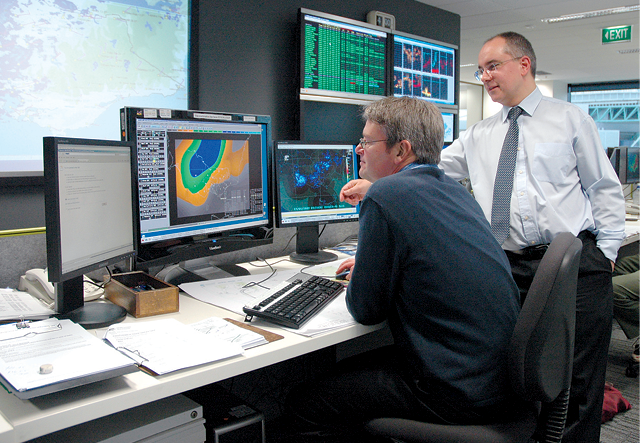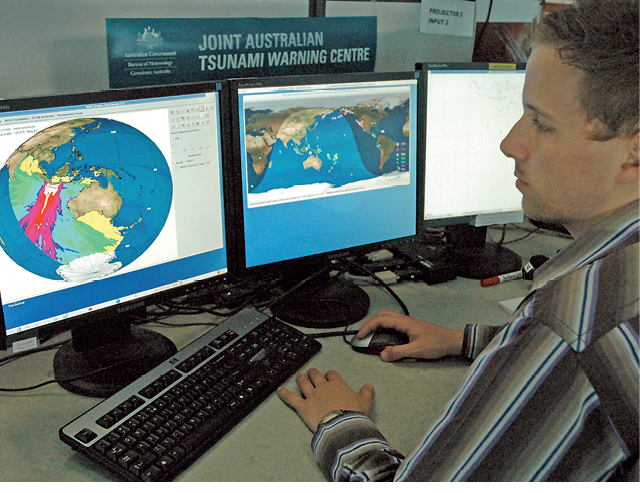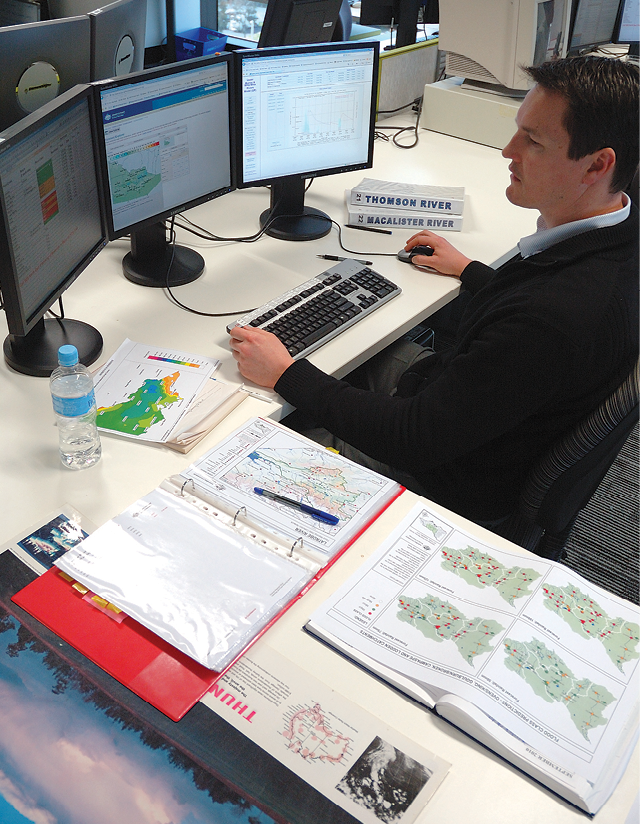A day in the life of the emergency sector
Kate Lahey
Article
Late last year, before an extraordinary spate of natural disasters flooded, burnt and shook the region, Campbell Darby was busy already. He was occupied not just with events like the sinking of an asylum seeker vessel off Christmas Island, or forest fires in Israel, but also with the knowledge that the world was short of jute—the natural fibre, like hessian, used to produce sandbags.
As Director General of Emergency Management Australia, within the Australian Government Attorney-General’s Department, Campbell Darby must turn his mind to many and varied things, sandbags among them.
While his department was offering help during a series of individual events in 2010, including an earlier Christchurch earthquake and the Pike River Mine disaster, heavy rain began to drench the east coast of Australia, generating flooding in Victoria and New South Wales.
“It [the flooding] was not particularly large, but enough to have us closely monitoring events, to have really close links with SES in Victoria and NSW, to be on the phone regularly to them to make sure they had all the support they needed,” Campbell Darby says.

Discussions over disaster charts.
Then, Victorian authorities asked for help in sourcing extra sandbags, he says. But earlier in 2010, jute crops were washed out creating a shortage of bags.
“We talked to other states about their supplies, made sure we could put Victoria in contact with suppliers who had them and made sure we kept the links between the various states and territories going so if that people did have stocks of sandbags which they were happy to release, they could be given to Victoria,” Campbell Darby says.
“Defence has a stock of them. We were really just making sure we knew where all these things were so we could provide that advice. We were keeping all the states and territories advised that ‘this might become a critical issue for us so you need to start looking to your supplies and get extra stocks if you can’.”
It might seem a small detail, but this kind of national coordination is Emergency Management Australia's (EMA) forte.
As a single entry point in and out of the Commonwealth Government, EMA provides information to different federal departments, including the Prime Minister and Cabinet, Health, Transport, Agriculture, Defence and more from an affected state.
It also works in reverse, allowing states to use a single Commonwealth contact for all their needs in a crisis. It can help anticipate which departments and agencies might be needed and when.
Among those agencies is Centrelink. In a crisis, it provides immediate financial help to victims, including grants through the Australian Disaster Recovery Payments and the Disaster Income Recovery Subsidy. The total amount paid to people by Centrelink in Disaster Recovery Payments from all recent disasters is about $1 billion dollars.
For the Queensland floods alone, between November 2010 and 17 June 2011, Centrelink paid out close to $464 million in disaster recovery payments, through almost 400,000 successful claims. It also paid $61 million in claims for the Disaster Income Recovery Subsidy, according to Centrelink information.
At the peak of the flood recovery effort there were up to 2500 Centrelink staff nationwide working on the crisis almost 10 per cent of the Centrelink workforce. They included 1300 staff taking calls from people in Queensland, NSW, Victoria, Western Australia and South Australia who had been affected by floods.
Hundreds of staff were based in recovery centres around Queensland, 30 in Victoria and some in NSW.
This was on top of Centrelink’s business-as-usual processing of tens of thousands of claims for payments such as Newstart, Age Pensions, Families and Carers.
Many Centrelink staff faced their own crises, just trying to get to work during the disasters.
According to Centrelink, one staff member who was caught in a flash flood near Ipswich put her mobile phone between her teeth as her car floated downstream and began filling with water. She managed to swim to safety.
She’d loaded all her valuables into the car, fearing her house would be washed away, and it was. So was her car. The next day, left with nothing and wearing borrowed clothes, she walked 7km to work.
Other Centrelink workers were reported to have ‘hitched’ rides with the SES on inflatable dinghies to get into isolated towns such as Condamine to reach residents who refused to leave their homes.
In Tasmania, staff worked nights and weekends as well as full time during the day to process flood claims and were later joined by 10 Medicare staff who received training to help process the Centrelink claims.
Centrelink also has a range of counsellors it can provide to an affected area. Social workers across NSW answered calls from people who had lost their homes, and those in south-west NSW helped answer calls for customers in Toowoomba and Rockhampton.
Centrelink’s General Manager, Hank Jongen says the disasters in the first few months of this year combined to create an unprecedented event that required a response far greater than anything the agency had seen in the past.
“Unquestionably, our most important role was the rapid response on the ground and our ability to provide relief and support to people with minimal bureaucracy,” Mr Jongen says.
“It boiled down to having a group of people on the ground who presented a friendly and supportive face for Government,” he says.
Mr Jongen says Centrelink learned from its response to the Victorian bushfires and was able to rapidly respond this year―having staff on the ground within hours of an alert coming through.
“Past experience also brought about the use of new technology such as the Centrelink Point of Presence (C-pop), which enabled staff in Queensland real-time access to their mainframe from anywhere, so they could process payments on the spot, even in badly affected and isolated areas,” he says.
Other Commonwealth agencies EMA works with are more heavily involved before disaster strikes.
The Bureau of Meteorology provides pre-season and long-range forecasts to help authorities plan ahead. As a severe weather event draws closer, their briefings to emergency services become more frequent and more specific. Specialists, like hydrologists, are drawn in to provide more specialised advice.

Cyclone data analysis.
Jim Davidson, the Bureau’s Queensland director, says this was the fourth wet season in a row, though bigger than the previous three. It was one of the strongest La Nina events in history and another rain indicator, sea surface temperatures surrounding Australia, was at record levels.
“We first started advising emergency management authorities in September, that’s when we were first getting signals that this would be an exceptional season,” he says.
The Bureau predicted six cyclones would fall in the Queensland area, and it received four plus a couple of intense monsoonal lows and other cyclones nearby.
“Between August and June, the Queensland Bureau issued 1730 flood warnings, he says.
“That’s by far the most ever, and 268 severe weather warnings, 429 severe storm warnings – it’s been a big year all round.
“It got to the stage in some of the warning centres where the word ‘record’ started losing significance, because we were setting records almost every day,” he says.
Mark Edwards is an engineer by background and the project leader for the engineering economics and exposure project with Geoscience Australia.
“By exposure we mean assets of value exposed to natural hazards, defining those on a national scale and how susceptible they are to a natural hazard, and what the economic implications and other metrics such as casualties are associated with that exposure,” Mr Edwards says.
His team also works with specialists who can simulate a disaster, such as an earthquake, tsunami or cyclone.
“We then take the simulation of that hazard, look at what’s exposed, how vulnerable it is and what it means in a risk process,” he says.
Staff range from software programmers to engineers, economists and climatologists.

Tsunami data analysis.
“If you really want to do risk, you need a really broad skill base because you need all of those elements to make as reliable as possible estimates of impact,” he says.
The team used information from recent disasters to inform its impact assessments―but also used their own information to predict how events might unfold.
“We had done work in the past into what we call ‘city studies’. We did systematic studies of a number of cities in Australia, looking at a range of hazards,” he says.
These previous studies included flood hazard and risk in south-east Queensland.
“The high risk areas in south east Queensland were already highlighted by our own work and the work of others.
“One of the things that was highlighted in the Brisbane flooding, and we saw that in our surveys, was development on land that was flood prone. We even saw, would you believe it, two-story houses inundated to the roof in that flooding. Why was development permitted in those areas?
“There’s a need not only to identify areas of high risk but to make sure you’re not building a legacy for the future.”
Mr Edwards maintains that building standards and fraught planning processes contributed to the inundation of homes, as did inappropriate building materials.
“If you think of traditional Queensland construction, the old Queenslander on high stumps was good for warmer weather and very good when it came to flooding you’re actually elevated,” Mr Edwards says.
“Today, flat-on-grade construction is quite common, so you’re only a few hundred millimetres above ground level, so inundation is rapid.”
Some modern construction materials are also more flood sensitive, he says. These include plasterboard and some glued wood products that never recover their strength after they’ve been wet.
“The old Queenslander with its hardwood floors and timber lined walls, was a lot less sensitive,” he says.
Mr Edwards says while the event that flooded Brisbane was very rare in the way it developed, future dangers may depend on whether these events will become more common, and more severe if we fail to adapt to climate change.
Campbell Darby says some of the things EMA hopes to achieve in the future are better ways to gain data on, and understand the impact of events.
“I think there are a range of technical measures we might be able to use. There’s a whole range of data sets that are available out there on demographics, on where critical infrastructure lies, on what the vulnerability of certain areas are, what the built environment is in a certain area, so that if you knew that you had a significant flood event in a particular region, you could actually probably do some modelling to say ‘all right, if that’s the level of the flood, we could expect x-number of houses flooded, we’re going to have major infrastructure issues with power, particularly in a cyclone,’ and what the impact might be on hospitals, what the impact might be on your transport nodes and lines of communications,” he says.
“You might be able to identify this is an area of a highly vulnerable population because of socio-economic circumstances, or age – you might be able to get down to that. I don’t think we could do it at the moment but I think future modelling and census data might start to give it a sense of those things,” he says.
Campbell Darby says EMA is now reviewing the recent events and trying to build its capability to better share information and support States and Territories.
“We’re working with Geoscience Australia, making sure we’ve got the best information to do the job we need to do. We’re also trying to sort out a whole lot of financial arrangements.
“I think we’ve come a long way in terms of having common standards, having interoperability between states and territories, in terms of the ability to deploy and work in other states and territories. There are still a number of rub points between jurisdictions in terms of such things as licensing, training and standards and even equipment compatibility but these issues have largely been overcome, and everybody is working to remove remaining obstacles.”
Information and predictions even national coordination can only help so much, and so far as people are willing to heed the warnings themselves.
Ray Canterford, the Bureau of Meteorology’s Division Head of Services for Aviation, Defence, Public, Marine, Disaster Mitigation and Oceans says the last season began with an unprecedented message from the Bureau “that this was going to be extremely heavy rainfall, more tropical cyclones than average and severe flooding”.
He says communities must learn how to prepare themselves to react to the warnings they are given.
“The community has to respond through well-established plans that have been put in place beforehand. Those plans should involve knowledge of evacuation areas, they should involve education to the community on what to do, they should involve self-awareness of where they are located with respect to a creek or a river or a bushfire area,” Mr Canterford says.
“A resilient community is one which doesn’t just rely on an event happening and then being told what to do. They already know what to do.
“You have to be aware of what your house is built to, what category of storm it can take.”
Similarly, NSW Fire and Rescue Chief Superintendent John Denny, who has been involved in Urban Search and Rescue Taskforces since they began in NSW, worked in both the Queensland floods and the aftermath of the Christchurch earthquake. He says the real heroes of those events were the local communities in those areas who responded first.

Flood data analysis.
The immediate and ongoing response by local people is extremely important, he says, not just in potentially saving lives but in ensuring they have control of their recovery processes and develop greater resilience to future events. “In parts of America they have Community Emergency Response Teams (CERTs) based on the fact that when bad things happen you’re not going to get a fire engine to every house or an ambulance to every patient, so they train people to survive and operate in the absence of professional emergency response,” Mr Denny says.
Some similar programs operate in certain areas in Australia, including bushfire prone areas of NSW, but could be expanded, he says.
“What it does is builds social capital so at the end of the day, whether a fire’s coming or not, they know―as a consequence of the community fire unit program―in number 15 of their street lives an old lady who’s going to require some assistance in an evacuation. So the community actually bonds and knows their vulnerability and responds to that, whether it be a bushfire or flood, or whatever. Building that social responsibility in small clusters is absolutely critical”.
About the author
Kate Lahey is a senior journalist, commissioned by the Attorney-General's Department. Kate has been tasked with interviewing key Australian Government representatives and community members to share their stories on responding to the natural hazard events earlier this year. This November edition features three more stories with more to come in the next edition.


